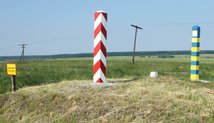Border: Poland-Ukraine
Date(s) of establishment: Current demarcation in 1945; Officially established in 1991Length of border: 535 km
Regions concerned: Poland – Lubelskie (Lublin), Podkarpackie (Subcarpathia); Ukraine – Volyn, Lviv, Transcarpathia
European programme(s):
- Cross-border Cooperation Programme "Poland - Belarus - Ukraine 2007-2013"
Website of the programme
The border between Poland and Ukraine is 535 km long. It begins at the tripoint formed by the Ukrainian, Polish and Slovak borders, in the middle of the Eastern Carpathian mountains. The demarcation runs initially towards the east, arriving at the Ushok Pass and the source of the San river, whereupon it turns north-west to follow the river for around 50 km. It subsequently leaves the river to take a north-easterly direction, crossing the region known as the “Przemyśl Gate”, where mountains meet lowlands. The border then crosses large swathes of agricultural land, to reach the Bug river, which forms the last third of its demarcation. It ends at the tripoint formed by the borders of Poland, Ukraine and Belarus.
History:
Between 1917 and 1920, Ukraine experienced a brief period of independence. This ended with the signing of the Peace of Riga (18 March 1921) which brought an end to the war between Soviet Russia and Poland. The two parties partitioned Ukraine, the Soviet portion becoming the Ukrainian Soviet Socialist Republic. A border separated it from Poland up to 1939.
As a result of the Second World War, the Yalta Conference set the border between Poland and the USSR with a demarcation close to that of the Curzon line (proposed in 1919-20). It was only in 1991, with the independence of Ukraine in relation to the USSR that the border between the Republic of Poland and the Republic of Ukraine officially came into being. Its demarcation has since remained unchanged.
This border has been an external border of the European Union since 2004, and of the Schengen Area since 2007. There are 12 border crossings (6 by road, 6 by rail).
Cross-border cooperation:
The cross-border cooperation programme that brings together Poland and Ukraine was initiated by the ENPI (European Neighbourhood and Partnership Instrument). The main objectives of the programme are: improving quality of life, developing the competitiveness of the region, and promoting the creation of cross-border networks and exchanges between the populations.
With regards to competitiveness, measures are focused on entrepreneurship, tourism and accessibility. Border security is one of the strands of the policy for improving quality of life, as Ukraine is not part of the European Union. The programme also orchestrates the implementation of several projects including a cross-border cycle path and the development of rescue services and common natural hazard management.
In addition to this programme, Poland and Ukraine form a strategic partnership. Immediately after the fall of the USSR, Poland attempted to renew ties with its eastern neighbours. Poland was thus the first state to recognise the independence of Ukraine, in December 1991. In 1992 the two countries signed a treaty on good neighbourliness and friendship, confirming their existing borders, then in 1994, the rules of the Polish-Ukrainian partnership were established.
Up to 1998, cross-border cooperation developed extensively in the context of commerce and trade. Export between the two countries rapidly increased and a common bank was set up in 1999. The population greatly contributed to the increase of these exchanges: in June 1996, the visa for cross-border movements was discontinued and today border traffic concerns around 10 million persons each year.
The Euroregions have also opened a new approach to cooperation. Indeed, the Carpathian and Bug euroregions supervise better cooperation at the local level, notably with regard to the management and protection of natural resources, and the development of cultural institutions.
More recently, the two countries participated jointly in the organisation of the UEFA European Championship football tournament (EURO 2012). This partnership is the symbol of a growing cooperation following the accession of Poland to the European Union.


